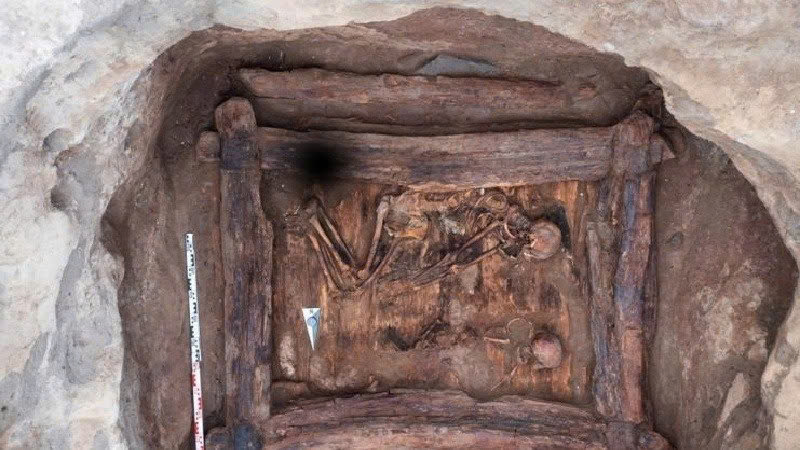Archaeologists have recently uncovered an extraordinary find in the Touran-Uyuk Valley of northern Tuva, Russia, often known as the “Siberian Valley of the Kings.” This remarkable discovery was made by a Polish-Russian team that unearthed a monumental burial mound dating back approximately 2,500 years. Among the astonishing findings were the remains of a woman buried with a wealth of precious artifacts, offering new insights into ancient cultural practices.
Unexpected Discoveries Challenge Traditional Beliefs
The excavation, spearheaded by researchers from Jagiellonian University in Kraków, unearthed the skeleton of a woman estimated to have been about 50 years old at the time of her death. One of the most intriguing aspects of this find was the presence of a golden pectoral ornament shaped like a crescent or sickle, which was buried alongside her remains. This artifact’s association with the woman challenges long-standing assumptions about societal roles in ancient cultures.

Dr. Łukasz Oleszczak, a prominent member of the research team, elaborated on the importance of this unique find, stating, “A particularly fascinating artifact was a golden pectoral ornament, a decoration worn around the neck in the shape of a sickle or crescent. Historically, such objects were almost exclusively found in the graves of men and were thought to symbolize membership in a specific social group or caste, perhaps warriors. Its presence in the grave of a woman is a striking deviation from tradition and provides clear evidence of the deceased’s unique role within the community of the Valley of the Kings.”
A Burial Site Rich with Artifacts and History
The burial mound, an impressive structure with a diameter of roughly 25 meters, contained not only the remains of the woman but also those of a young child, estimated to have been about two or three years old. Alongside the remains, the archaeologists uncovered an array of artifacts, including:
- Bronze mirrors
- Gold earrings
- An iron knife
- A decorated wooden comb in excellent condition
In total, the site revealed the remains of five individuals, all buried with an assortment of grave goods that spoke volumes about their cultural and social significance. These artifacts, meticulously preserved, provide valuable insight into the customs and material culture of the era.
Modern Technology Fuels Breakthroughs in Archaeology
One of the key factors behind the success of this excavation was the application of cutting-edge technology. The team employed aerial laser scanning techniques, which enabled them to identify two graves within the site as early as 2021. This innovative approach underscores the transformative potential of modern technology in archaeological research, allowing experts to uncover and study ancient sites with unprecedented precision.
Historical Context: The Legacy of the Scythians
The burial mound is attributed to the Scythians, a group of nomadic peoples who roamed the steppes stretching from the Black Sea to China between roughly 800 B.C. and A.D. 300. The woman’s burial, which dates back to the 6th century BCE, offers a rare glimpse into Scythian life, shedding light on their cultural practices, social structures, and attitudes toward gender roles.
Dr. Oleszczak remarked on the woman’s prominent status, noting, “It appears that, much like the other individuals buried in this barrow, she was part of the prince’s entourage.” This assertion suggests that her role within the community was one of considerable importance, further evidenced by the high-value items found alongside her remains.
Challenging Gender Norms in Scythian Society
One of the most compelling aspects of this discovery is how it challenges preconceived notions about gender roles in Scythian culture. The golden pectoral ornament, traditionally associated with male warriors or elite members of society, provides strong evidence that women could occupy significant and perhaps even unconventional positions of power or influence within their communities. This revelation not only deepens our understanding of Scythian society but also invites further exploration into how gender roles may have varied across different ancient cultures.
A Discovery of Global Significance
The findings from the Touran-Uyuk Valley are more than just an archaeological milestone; they represent a window into a world that existed 2,500 years ago. Each artifact, from the exquisitely crafted gold earrings to the intricately decorated wooden comb, tells a story of a people whose lives were rich with tradition, artistry, and social complexity.
Furthermore, the burial mound itself speaks to the Scythians’ reverence for their dead and their sophisticated burial practices. The size and complexity of the mound, along with the wealth of artifacts it contained, suggest a culture that placed great importance on commemorating the lives of its members, particularly those of high status.
Opening New Avenues for Research
This extraordinary discovery not only enriches our understanding of Scythian culture but also opens new avenues for research into ancient societies. It prompts questions about how roles and identities were constructed and recognized, especially in relation to gender. Could this find indicate that Scythian women played more diverse roles than previously believed? Or does it suggest that social and cultural norms in this region were more fluid than those of neighboring societies? These are questions that researchers will continue to explore as they study the artifacts and context of this remarkable burial site.
A Legacy to Explore
The uncovering of the woman’s burial in the Siberian Valley of the Kings serves as a powerful reminder of the enduring relevance of archaeology. By piecing together the fragments of the past, researchers not only reconstruct ancient lives but also challenge modern perceptions of history and culture. This find is a testament to the resilience and ingenuity of human societies and the stories they leave behind, waiting to be discovered and understood.
As the analysis of this burial mound continues, it will undoubtedly provide even more insights into the lives and legacies of the Scythians, ensuring that their rich history remains a source of fascination and learning for generations to come.





